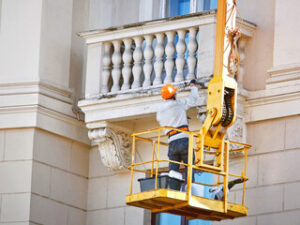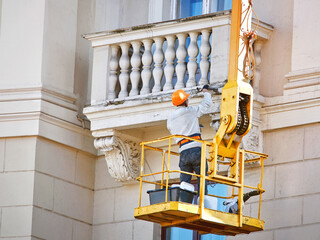Stucco Repair can be a costly and time-consuming endeavor. Depending on what kind of damage your home is experiencing, you may need to invest in remediation instead of simply repairing surface issues.
 Look for warning signs such as spotting, discoloration, and cracking. These are often indicators of underlying moisture that could lead to mildew, mold, and wall rot. To learn more about stucco repair, visit Stucco Repair Philadelphia.
Look for warning signs such as spotting, discoloration, and cracking. These are often indicators of underlying moisture that could lead to mildew, mold, and wall rot. To learn more about stucco repair, visit Stucco Repair Philadelphia.
Stucco has been a favorite building material for centuries. It adds visual interest and longevity to building frames, is easy to clean and maintain, and provides good insulation for the home. However, it can crack, especially in areas of high wind or where the structure is built on a weaker foundation.
Small cracks in stucco can be repaired with a little DIY know-how. You will need a caulking gun and some basic supplies, such as a cold chisel and hammer, masonry saw and blade and stucco mixture. Small hairline cracks can be easily filled with a caulk and painted over. The thickness of the paint bridges the crack and makes it essentially invisible. We recommend using Plascon Micatex paint because it is textured and much thicker than traditional paint, making it an excellent cover for cracks in stucco.
Larger cracks are more serious and require a complete repair process. Start by pressure-washing the crack and cleaning away any dirt or mold. Then, remove any loose plaster and replace it with new building paper and metal lath. This step is crucial for the integrity of the stucco and will ensure that moisture doesn’t get into the wall, which can cause further damage.
If the crack is only in the finish coat, wire-brush and wet the brown coat. Apply a fresh layer of bonding liquid and trowel in a new finishing coat. If the crack is in a deeper area of plaster, you will need to undercut it with a chisel and hammer. The goal is to widen the bottom of the crack, but only enough to allow for a mechanical key in (hold) the new stucco. Then, you can use the same technique as for patching and trowel in a fresh finishing coat.
For the cracks in your stucco that are larger than a dime, first, you will need to remove any loose or crumbling plaster and replace it with new building paper and lath. Then, you can use either a pre-mixed patch product that comes ready to trowel on or conventional stucco mix, mixed in a wheelbarrow or plastic tray according to the manufacturer’s instructions. If you are using a pre-mixed product, it’s important to choose one that is compatible with cement and will not bleed.
Remediation
Stucco is one of the most popular home-building materials today, especially in newer homes. While it’s beautiful and durable, it can also be vulnerable to moisture and mold problems. In such cases, a stucco remediation is necessary to prevent lasting damage to the structure of your home.
Remediation is a process that involves identifying the source of moisture intrusion and correcting it, which will ultimately result in replacing your building’s entire stucco system. It is typically the most comprehensive solution for this issue, and it minimizes the likelihood that you will need to make additional repairs in the future.
The first step in remediating a problem with your stucco is to remove any material that may be impacted by mold and mildew, including sheathing and plywood, as well as any insulation or OSB board that may have become saturated with these substances. This is an essential part of the process because it allows for a thorough inspection of the structure. It also helps to identify the extent of the damage and how it is affecting your home’s structural integrity.
A responsible remediation contractor will take the time to determine how water and moisture are getting into your home, because that is the only way to ensure it doesn’t happen again. This will include a careful examination of the stucco and surrounding materials, which can help to find the source of the problem.
When your stucco needs to be repaired, the first thing you should do is clean the area with a wire brush and cleanser. This will make sure the patch will adhere properly to the surface of your stucco. Next, pull back the metal lath on the non-damaged portion of your wall to expose the damaged area. Pulling back the lath will give you a little more space to work with, so it is easier to spot the problem areas and repair them.
Cracks and flakes are the most common warning signs of impending stucco failure, but you should also keep an eye out for staining around windows or doors, as this could indicate rotted wood or dry rot. If you notice these or any other signs of underlying damage, contact a stucco specialist right away.
Repairing Stained Areas
Stucco is a versatile material that comes in many colors and textures, but it can also be susceptible to moisture damage. While some staining is caused by severe weather events and overexposure to sunlight, a large portion of this problem stems from poor application and maintenance practices. Stained stucco is an indication of moisture intrusion that can have a major effect on the surrounding areas of your home. Remediation can be expensive, but it can prevent the need for future repairs and protect the interior structures of your home from water penetration.
The first step in repairing stained areas is to clean the affected area thoroughly. This is a delicate process that should not involve getting rough on the surface of your stucco. Instead, the best approach is to saturate or pre-wet the area with water so that any dirt and discoloration is drawn to the top of the wall. After the cleaning process, you should allow the area to dry completely.
If the stains are stubborn, you may need to scrub them off with a soft brush or a power washing machine. Once the stains are removed, you can apply a new coat of stucco to the damaged area. This should be a base coat that is a quarter-inch thick and should be a solid color. Once this layer is applied, you can apply a finish coat that matches the existing texture of your stucco. If you are unsure of the right mix to use, you can always purchase coloring pigment and add it into your mix until it matches the existing color.
While you may be tempted to paint your newly repaired stucco, you should wait a week before doing so. During this time, the stucco will continue to cure and will be a more even surface for your next coat of paint.
If your stucco is in need of minor repair, you may be able to tackle the project yourself with some planning and prep work. However, if your stucco is experiencing significant problems, it is important to consult with an experienced contractor to determine the best course of action.
Repairing Water Damage
Often when a stucco home has water damage, it isn’t something that can be easily fixed. That’s because the underlying issues have to be addressed in order to prevent moisture penetration, and subsequent problems such as mold or wood rot. In addition, this kind of damage can disqualify homeowners from making a claim on their homeowners insurance.
Luckily, a skilled contractor can repair the underlying issues and restore the stucco to its original condition. While remediation costs more than simply repairing cracks or staining, it protects your home from more costly problems in the future and can save you thousands of dollars.
When a stucco home shows signs of water damage, such as bubbling or blistering, it’s important to have it assessed by a professional. The reason is that the problem may be caused by a poorly installed stucco, which can lead to trapped moisture behind the wall and subsequent problems.
First, a qualified technician will perform an inspection to determine the cause of the moisture. This involves inserting a probe into suspicious areas of the walls and taking moisture readings. The results will show how much moisture is in the wall cavity, which can then be repaired and sealed.
Next, the damaged section of the stucco will need to be removed. A mason’s chisel or hammer can be used to remove the old stucco and loose materials from the wall surface. Once the area is clean, a layer of new stucco mix can be applied to the damaged area. This first coat is called a scratch coat and is usually brown in color. A notched trowel is then used to create grooves into the mud, which helps future layers adhere.
Once the scratch coat has set, a second and third coat of stucco can be applied to the area. The color of these layers can be chosen, but it’s best to keep the overall appearance of the house consistent. The new stucco can be sanded to smooth it before applying the finishing coating, which will be the final step of this process.
